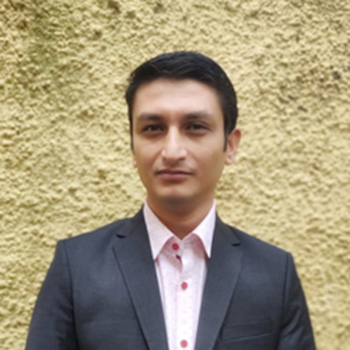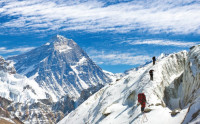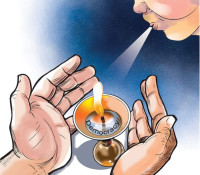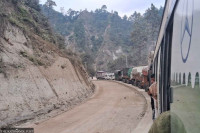Opinion
The privilege to choose
It’s increasingly clear that our liberal standards come with the freedom to choose our protests
Amish Mulmi
When a fasting doctor energises disparate elements of Nepali civil society together, one can be assured that the pillars of our democracy are still on solid ground, even if the structure itself seems shaky at times. Several commentators presented their views on DrGovind KC’s fast for better health services in rural areas and against what has been termed the medical college mafia. State security services made a ‘disproportionate use of force’—firing live bullets inside the Jumla hospital, or using tear gas or baton-charging protesters. Several others enjoined Dr KC in his fast. The Nepali Congress suddenly discovered a voice, although one recalled its government’s lack of concern towards Dr KC’s demands on a previous fast. As of writing, talks between the government and Dr KC’s had been heading towards a positive resolution. There was little doubt Dr KC’s demands for a more accessible health service infrastructure were justified; despite our impressive gains in several indicators, rural areas still suffer from a troubling paucity of health services, while an overwhelming number of medical colleges are centred in Kathmandu.
There have also been several voices, including yours truly, who’ve commented on the Oli government’s tilt towards an authoritarian bent with its actions in the past few months. One of the signs of a well-functioning democracy is the presence of multiple voices, including voices of dissent. We have a reasonably free press that allows for vociferous debates on issues. The stakes were high for the Oli government in how it dealt with the current crisis; its response could either be a weapon for the opposition, or a boost to its own credentials.
All in all, it seems our democracy is untroubled by most accounts. Yet, several things have bothered me these past few weeks.
Now, I am not a political analyst by training, nor am I an activist. Yet, the support that Dr KC’s protest found, and the queries at the government’s various directives that curtail civil liberties, both raised a few questions in my mind: Where was our civil society when these same parties—andleaders—decided to frame a ‘fast-track’ constitution that, till date, denies women the same rights as men? Where was our voice when the Madhes was burning, and nearly 50 people, including children, were shot dead by the state? Subsequently, this leads me to ask, what are the contours within which our civil society activists operate? And how are these contours shaped?
Whataboutery experts will argue the Madhes violence was precipitated by the Kailali violence, while the Indian blockade had impugned on Nepal’s sovereignty. But while the entire world could read about India’s blockade – courtesy our commentators and civil society activists, either in mass media or on social media – at home we were busy decrying human rights reports that stated in plain words Kathmandu’s apathy towards the violence in Madhes. And it was not that the reports declared the protesters were blameless. “There is, in short, compelling evidence of criminal attacks on defenseless police by protesters, and abundant evidence in several cases of serious crimes by police against protesters and bystanders, including disproportionate use of force and extrajudicial killings,” the controversial report by Human Rights Watch declared (emphasis mine).
A nation of ironies
Scratching the old wounds of the Madhes protests of 2015 will divide opinions. Our leaders made sure it would polarise Nepali society even further. But how is it that we continue to deny equal rights to more than half of our population through our statute? Why should a Nepali woman not possess the same rights as a Nepali man?
“Our bodies are considered mere vessels for men to pass on their nationality, be that foreign or Nepali,” Manjushree Thapa wrote in the aftermath of the statute being passed. To read these words today, nearly three years after an unequal constitution that still has not found enough support to be amended, should bring about a sense of deep shame. If there was enough pressure, both from civil society and political parties, amending this clause to reflect equality between the sexes in our statute would not be too controversial a decision. Is the demand, therefore, not valid? Should it not be addressed? And subsequently, should we not be making an issue of it?
One may argue that our constitution allows for 33 percent representation of women in Parliament. But formulating a law, and implementing it, are two very different things, as the law on banning chhaupadi has shown. This government’s views on women and their representation in public spaces are well known. A minister had to resign for his most inappropriate comments about women-students. Reservation laws have been twisted to reflect tokenism, but that’s it. Our paranoia around illegal immigration from the south has ensured any modification of citizenship laws will face the invisible, but very real, barrier of Nepali nationalism. Ironic, then, that Nepal remains one of the few countries in the world whose constitution does not grant the same rights to women as to men, despite provisions regarding their representation.
Us and them
I have long felt that the Madhes civil rights project could have been more inclusive; that it needed to align itself with the other minorities of Nepal, and show that it could adequately address the diversity of Nepal within its demands. The larger issue was one of representation, especially the overwhelming representation of particular caste groups in government services. If the Madhes continued to make demands positioning itself as the only victim in an unequal society dominated by a few, several contrarian positions could be made.
Ultimately, when the protests began to burn the plains, those who ruled Kathmandu were successful in projecting the movement in an ‘us-versus-them’ binary. And we—as commentators, authors, activists, media professionals—fell victim to the same blindness. We began to rail against India for the blockade, and against its ‘agents’, the Madhes protesters. We argued that the protests, and the blockade, were an attempt by a foreign power to subvert sovereignty (even if it was the same foreign power whose disavowal of ‘constitutional monarchy’ was one of the reasons the king finally backed down in 2006). We said the blockade had eroded whatever goodwill the people of the plains had in the hills, and we left them adrift. After all, we had suffered an earthquake, and a constitution, no matter how unequal it was, was more important than anything else at that moment. In lending support to such a constitution, we displayed our own shortsightedness.
Dr KC’s demands were fully valid, in that any citizen’s demands for better governance practices and transparency were. But to see Kathmandu’s civil society finding its voice, and raising slogans against authoritarianism, reminded me of those troubled months in 2015, when one struggled to find voices that would tell the government it was shooting its own citizens, that perhaps the new state could treat them better than the royals and the Ranas. The presence of a few voices of calm did not do much good; a friend who belongs to the hills, one of the few who stood outside Parliament with a sign saying ‘Kathmandu with Madhes’ then, remembers the vicious abuse directed at him online and offline for standing up to the state’s violence.
Much (muddy) water has flown under the Bagmati since, and perhaps those who refused to stand up to government policies then now recall Martin Niemoller’s celebrated quote, ‘First they came for the socialists…’ But it’s increasingly clear that our liberal standards come with the freedom to choose our protests. Imagine having that sort of privilege: of fighting because you want to, and not because you need to.




 6.21°C Kathmandu
6.21°C Kathmandu












